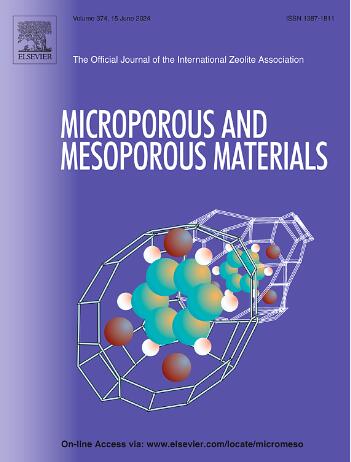3D printed mullite monoliths with triply periodic minimal surface (TPMS) architectures functionalized with HKUST-1 for CO2 capture
IF 4.8
3区 材料科学
Q1 CHEMISTRY, APPLIED
引用次数: 0
Abstract
Ceramic porous scaffolds functionalized with Metal Organic Frameworks (MOFs) are promising systems for carbon capture, providing a valuable strategy to decrease CO2 atmospheric concentration and mitigating the dramatic issues related to global warming. Thus, the present work focuses on the combination of a highly microporous CO2 adsorbent HKUST-1 coating with porous and interconnected mullite (3Al2O3⋅2SiO2) substrates obtained by a combination of additive manufacturing and impregnation techniques, before a complete characterization of their CO2-sorption properties. Two triply periodic minimal surface (TPMS) architectures, Schwartz Primitive and gyroid, were fabricated with high resolution and accuracy by Digital Light Processing, using two mullite powders, labelled Mc and Mf, presenting different compositions and particle size distribution. Mullite monoliths were functionalized with a continuous HKUST-1 (Cu3(BTC)2) coating. The impact of the type of architecture on the amount of deposited HKUST-1 and the sorption capacity were monitored. MOFs mass intakes reached 4.2 and 3.9 wt% for Mc Schwartz primitive and gyroid respectively. The textural properties and CO2 sorption capacity of the materials were studied by N2 and CO2 sorption at 77 K and 298 K respectively. CO2 gas chromatography was performed at different temperatures (32 °C–80 °C) and gas flows (10–40 mL/min) using a filled column with the different materials. TPMS monoliths were compared to traditional adsorbent powder bed in terms of pressure drops, permeability, gas speed and retention time normalized by MOFs amount, highlighting the advantages of the shaping approaches with respect to powder beds. High permeabilities were reached (Darcy's coefficient k ≈ 10 x10−13 m2 for Mc Schwartz). Monoliths also promoted CO2/adsorbent contact time, lowering the gas speed below 1.5 cm/s, compared to 2–5 cm/s, in the case of powder bed. HKUST-1 functionalized TPMS monoliths drastically enhanced the CO2 retention time normalized by MOFs amount, with values increased by a factor 6, from 7 s/g for the powder bed to 30 s/g and 20 s/g for gyroid and Schwartz primitive scaffolds respectively. This work represents a crucial step forward in the development of hierarchically porous and geometrically complex carbon capture and storage systems. Indeed, the current work goes beyond our previous studies by producing and comparing different TPMS designs and introducing for the first time gas chromatography to demonstrate the advantages of TPMS scaffolds in enhancing CO2 adsorption efficiency.

具有三周期最小表面(TPMS)结构的3D打印莫来石单体,具有HKUST-1功能,用于二氧化碳捕获
金属有机骨架功能化的陶瓷多孔支架是一种很有前途的碳捕获系统,为降低大气中二氧化碳浓度和缓解与全球变暖有关的重大问题提供了有价值的策略。因此,本研究的重点是将高微孔CO2吸附剂HKUST-1涂层与通过增材制造和浸渍技术相结合获得的多孔互联莫来石(3Al2O3·2SiO2)衬底相结合,然后对其CO2吸附性能进行完整表征。采用数字光处理技术,利用Mc和Mf两种不同成分和粒径分布的莫来石粉末,以高分辨率和高精度制备了两个三周期最小表面结构(TPMS): Schwartz Primitive和gyroid。用连续的HKUST-1 (Cu3(BTC)2)涂层对莫来石单体进行功能化。监测了结构类型对沉积的HKUST-1的数量和吸附能力的影响。mcschwartz原始饲料和gyroid饲料的mof质量摄入量分别达到4.2和3.9 wt%。分别在77 K和298 K条件下进行N2和CO2吸附,研究了材料的织构性能和CO2吸附能力。在不同温度(32°C - 80°C)和气体流量(10-40 mL/min)下,使用不同材料的填充柱进行CO2气相色谱。将TPMS单体与传统吸附剂粉末床在压降、渗透率、气速和按MOFs量归一化的停留时间方面进行了比较,突出了成型方法相对于粉末床的优势。达到了高渗透率(达西系数k≈10 × 10−13 m2为Mc Schwartz)。整体柱还促进了CO2/吸附剂的接触时间,将气体速度降低到1.5 cm/s以下,而粉末床的气体速度为2-5 cm/s。hust -1功能化的TPMS单体极大地提高了按mof量归一化的CO2保留时间,其值增加了6倍,从粉末床的7 s/g增加到gyroid和Schwartz原始支架的30 s/g和20 s/g。这项工作代表了在分层多孔和几何复杂的碳捕获和存储系统的发展中向前迈出的关键一步。事实上,目前的工作超越了我们之前的研究,通过制作和比较不同的TPMS设计,并首次引入气相色谱法来证明TPMS支架在提高CO2吸附效率方面的优势。
本文章由计算机程序翻译,如有差异,请以英文原文为准。
求助全文
约1分钟内获得全文
求助全文
来源期刊

Microporous and Mesoporous Materials
化学-材料科学:综合
CiteScore
10.70
自引率
5.80%
发文量
649
审稿时长
26 days
期刊介绍:
Microporous and Mesoporous Materials covers novel and significant aspects of porous solids classified as either microporous (pore size up to 2 nm) or mesoporous (pore size 2 to 50 nm). The porosity should have a specific impact on the material properties or application. Typical examples are zeolites and zeolite-like materials, pillared materials, clathrasils and clathrates, carbon molecular sieves, ordered mesoporous materials, organic/inorganic porous hybrid materials, or porous metal oxides. Both natural and synthetic porous materials are within the scope of the journal.
Topics which are particularly of interest include:
All aspects of natural microporous and mesoporous solids
The synthesis of crystalline or amorphous porous materials
The physico-chemical characterization of microporous and mesoporous solids, especially spectroscopic and microscopic
The modification of microporous and mesoporous solids, for example by ion exchange or solid-state reactions
All topics related to diffusion of mobile species in the pores of microporous and mesoporous materials
Adsorption (and other separation techniques) using microporous or mesoporous adsorbents
Catalysis by microporous and mesoporous materials
Host/guest interactions
Theoretical chemistry and modelling of host/guest interactions
All topics related to the application of microporous and mesoporous materials in industrial catalysis, separation technology, environmental protection, electrochemistry, membranes, sensors, optical devices, etc.
 求助内容:
求助内容: 应助结果提醒方式:
应助结果提醒方式:


